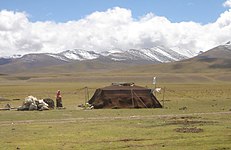Prossinia
Republic of Prossinia Republikinn Prossinië ᠫᠷᠣᠰᠰᠢᠨᠢᠶᠠ | |
|---|---|
| Capital | Yakatra |
| Largest largest city | Joblianja |
| Official languages | Prossinian, Karkut |
| Demonym(s) | Prossinian |
| Government | Unitary parliamentary constitutional republic |
| Markus Nalstrayva | |
| Gertrev Jasko | |
| Sonja Lorechev | |
| Legislature | Parliament |
| Establishment | |
• Under Karkut Empire | 1250-1320 |
• Empire of Prossinia | 1530-1815 |
| 1815 | |
• Revolt of 1864 | 1864 |
• Republic of Prossinia | 1864 |
| Area | |
• | 2,234,899 km2 (862,899 sq mi) |
| Population | |
• 2021 estimate | 35,789,000 |
• 2016 census | 33,488,989 |
| GDP (PPP) | 2021 estimate |
• Total | $1.2 trillion |
• Per capita | $24,244 |
| GDP (nominal) | 2021 estimate |
• Total | $1.6 trillion |
• Per capita | $22,650 |
| Gini (2020) | medium |
| HDI (2020) | very high |
| Currency | Prossinian Dinar (PRD) |
| Date format | yyyy/mm/dd |
| Driving side | right |
| Calling code | +677 |
| Internet TLD | .ps |
Prossinia (Prossinian: Prossinië), officially the Republic of Prossinia (Prossinian: Republikinn Prossinië), is a landlocked country located in the continent of North Utopia. It is bordered by Regmotto, Karkutia, Narvistan, Danitriss, and East Cammotand. Prossinia covers two million kilometres squared which includes plains, arid steppe and tundra in the north, the majority live in the centrak low lying plain. Prossinia is a unitary parliamentary constitutional republic. Prossinia has made a slow recovery in both demographics and economy since the end of the expansionist era. Prossinia is a member of the Universal Pact and Utopian Union after a referendum in 2021.
History
Under Karkut Empire
Early Kingdom of Prossinia
Empire of Prossinia
Northern Exploration
Revolts of 1815
Revolts of 1864 and Creation of The Prossinian Republic
Socialist Republic of Prossinia
Republic of Prossinia(1983-present)
Geography
Prossinia is located in the northern uplands of North Utopia and has an area of 2 million square kilometres. Prossinia covers steppe in the south, vast regions of forrested plateau and agricultural land in the west and centre and tundra in the north and east. Prossinia is bordered to the north by Regmotto to the south by Karkutia, to the west by Narvistan and to the east by East Cammotand and Dantriss. The largest mountain chain in Prossinia is the great southern mountains which make up part of the Great North Utopian Steppe. Other large mountain chains include the Lurenesk mountains in the east of the country. There are minor ranges such as the Baiak range in the north and the Muskavy hills in the north west. The south of Prossinia is made up of steppe and is the least populated part of the country. It is home to Prossinian-Karkuts this is the harshest and most mountainous part of Prossinia. The centre of Prossinia is flatter with rolling hills and is dominated by forests and rivers it in contrast is the most populated part of Prossinia and is home to the largest city Joblianja and the capital Yakatra. The north of Prossinia is just under the arctic circle and as a result is filled with tundra and permafrost. There are several areas such as the Baiak region that are populated along the coast of Lake Baiak which is the largest and deepest lake in the world. In terms of rivers the Ydsestra is the longest river in Prossinia and flows through the capital Yakatra, it was so important to the development of the nation that it is represented on the national flag. It flows from the Southern mountains into the central Prossinian plateau.
Climate
Politics
Foreign relations
Administrative divisions
Armed forces
Economy
Transport & infrastructure
Energy
Demographics
Healthcare
Religion
Education
Culture
Literature
Prossinia has a long legacy of literature and arts and is considered to have some of the most influential and developed literary spheres. The most influential Prossinian writers have all come in the 1860’s with the likes of Daniel Gholakin and Androv Nasyvzin being the most famous. In the late 1800’s Prossinian literature went through its golden age where it was renowned for its political satire and wit. Prossinian philosophy has gone on to influence several political movements including both the current government and opposition through ideas which led to the creation of the Prossinian welfare system and its current political freedoms and freedom of the press.
Art
Media
Prossinia has thousands of media outlets across a vast range of mediums. In newspapers the most popular tend to be Prossinii Liiset which is a centre left newspaper. The main centre right newspaper is the Siiudi. There are others that cover the rest of the political spectrum. The state television corporation runs across four channels with there being at least fifty other independent television stations. Radio is also run by hundreds of independent stations as well as there being four state run stations. The Prossinian press is one of the freest in the world and as such churns out high quality journalism on a daily basis.







